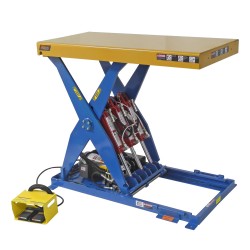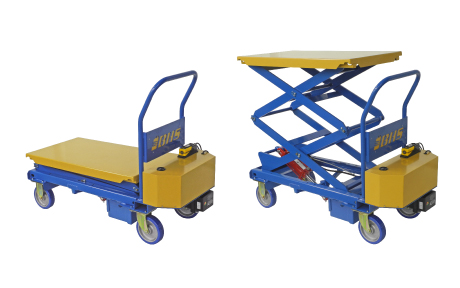We use cookies to make your experience better. To comply with the new e-Privacy directive, we need to ask for your consent to set the cookies. Learn more.
Choosing Lift Tables for Ergonomic Benefits
Industrial lift tables solve two major ergonomic challenges at once. First, they eliminate the need for manual lifts, a leading cause of workplace injury. Just as powerfully, they allow workers to position tasks within a comfortable range of movement. Together, these benefits can prevent the most common causes of musculoskeletal injuries in a variety of workplaces, from assembly lines to fulfillment warehouses.
When business owners invest in mission-critical equipment, they need to know that these devices will perform flawlessly for years. But the market is flush with lift tables from competing manufacturers all over the world, and it can be difficult to judge relative merits at a glance. This paper will investigate the fundamental design characteristics that differentiate one lift table from another, ultimately championing the benefits of BHS products. First, though, we will take a closer look at the problems lift tables are built to solve.
Ergonomics in Industrial Settings
The human body operates along complex biomechanical principles. When employers ask staff to violate those principles, they court disaster. Requiring staff to lift heavy loads is like telling a production line worker to turn screws with a butter knife — they can probably manage the task, but both the work and the tool will suffer for it.
The study of human biomechanics in the workplace is called ergonomics, and it is not just a buzzword. Ergonomic interventions can reduce injury rates, improve productivity, and create a safer, happier place of business at every level.
The stakes are quite high, especially in warehousing and manufacturing applications. According to the Bureau of Labor Statistics (BLS), the top cause of workplace injuries was "overexertion and bodily reaction" in 2014.

Figure 1. BHS Lift Tables can prevent musculoskeletal injuries by positioning work at custom heights, and by eliminating the need for staff to manually lift heavy loads.
That year, the BLS tracked 365,580 incidents of musculoskeletal disorders (think pulled muscles, sprains, and lower back pain) caused by excessive lifting. That is an incidence rate of 33.8 per 10,000 employees.
When workers get injured, they miss work. In 2014, people suffering from musculoskeletal disorders associated with workplace lifting took a median of 13 sick days. That translates into assembly lines falling behind schedule, late order fulfillment in warehouses, and a fortune in sick pay across all industries.
If these injuries arise from the tension between the body's biomechanics and the job's requirements, a technological solution makes the most sense. Indeed, the National Institute for Occupational Safety and Health (NIOSH) recommends "using lift-assist devices like scissor lift tables or load levelers" to remove serious ergonomic hazards.
The goal of every ergonomic intervention is to "improve the fit" between the worker and the work, according to NIOSH. But every human body is different. Only lift tables give staff the opportunity to alter work heights to perfectly match the form and function of their unique bodies.
That said, there are a lot of lift tables on the market, and they are not all created equal. These are the factors that every manager should consider before making the crucial investment in lift tables:
A Comparative Anatomy of Lift Tables
Scissor lifts are the industry standard for variable-height workstations. These surfaces stand on pantographic legs which attach at a pivot point. When a user engages the power, hydraulic or pneumatic pistons push the base of the legs horizontally along the frame. Through the pivot, this action moves the table surface up and down.
That basic motion is where the similarities between lift tables end. When comparing brands, consider these fundamental design differences:
-
Materials
The whole point of a lift table is to raise and lower loads that could otherwise injure humans. Considering the daily demands placed on these machines, durability is a major factor to consider when choosing a brand.Some manufacturers use cheaper, lighter-weight aluminum components. Steel is far more reliable. Heavy duty steel construction for frames, tables, and scissor legs allow greater capacities — up to 6,000 pounds for off-the-floor models from BHS.
-
Lift Cylinders
Most users prefer hydraulic power to pneumatic systems. Hydraulic lift cylinders do not require external air systems, and they are incredibly reliable.A third option, the mechanical lift, offers outstanding performance, but it comes at a heavy price. Mechanical systems often cost twice as much as their hydraulic counterparts without commensurate benefits.
In the mid-2000s, automotive manufacturers developed a trend of switching from hydraulic to pneumatic power. They were concerned about hydraulic fluid leaks, they said. This is not a concern with BHS Scissor Lift Tables. These machines incorporate heavy-duty braided wire on all hydraulic lines, while honed cylinders provide an exceptional seal. Many automotive manufacturers find themselves switching back to hydraulic power for its strength and reliability.
Dual lift cylinders — like those found on BHS Lift Tables — provide better performance than a single-cylinder builds. Managers should steer clear of single-cylinder lift tables, except in the lightest applications.
-
Proprietary Components
Many manufacturers try to ensure an ongoing revenue stream by using only proprietary components in their equipment. That way, when a part fails, customers can only buy the replacement from the original manufacturer.Engineers at BHS value the customer's experience more than the bottom line. Every BHS Lift Table uses top-quality, but non-proprietary, components. Replacements are rare, but if a BHS customer provides in-house maintenance, their technicians can easily find affordable replacement parts by comparison shopping.
-
Country of Origin
Labor laws obviously differ from one nation to another, and that can translate directly into quality issues with products. Lift tables built in China are often less dependable than those built with pride by well-paid workers on American soil.Many of the lift tables on the market come from China. In contrast, all BHS products are assembled in a 128,000-square-foot manufacturing facility in St. Louis, Missouri, U.S.A.
-
Custom Options
Most manufacturers of lift tables offer a limited range of models and options. At BHS, engineers and manufacturing staff collaborate with clients to build lift tables to any specification.End-users can choose a variety of lift capacities, table tops, and accessories, or they can have engineers design a custom solution from the ground up.
Comparing Mobile and Stationary Lift Tables
The choice between a mobile and a bolt-down lift table boils down to one thing: application. If staff members need to transport loads from one workstation to another, a mobile lift table provides obvious benefits.

Figure 2. The compact Powered Mobile Lift Table by BHS has dual scissor legs that lift the surface to 79.625" height and lower to 18".
For semi-permanent workstations, stationary lift tables are the better choice. While portable lift tables are quite stable, nothing can match the stability of a steel frame bolted into the floor.
There is also the issue of minimum height. In many applications, staff use lift tables to raise loads from floor-level. Casters often add to the minimum height of a lift table's surface. For instance, Powered Mobile Lift Tables from BHS collapse down to a minimum table height of 18 inches, compared to just 8.5 inches for stationary Scissor Lift Tables. Note, however, that the BHS Manual Mobile Lift Table also achieves the collapsed table height of 8.5 inches. Unique cutouts at the edges of the table surface make this feat possible.
Regardless of minimum heights, BHS offers optional Loading Ramps to make access to table surfaces simple. In short, BHS can design its way around any workplace task imaginable. Still, when choosing between mobile and stationary lifts, managers should weigh stability and height versus portability.
Safety Features Place BHS Lift Tables in the Lead
For managers in material handling and manufacturing applications, the question is not whether to provide lift tables. It is which lift table to choose.
Scissor Lift Tables and Mobile Lift Tables from BHS provide exceptional reliability for any positioning task. They also include powerful safety features that many competitors cannot match.
For instance, velocity fuses in BHS hydraulic lines immediately lock cylinders when they detect a loss of pressure. That freezes the table at its current height, preventing dangerous and costly collapse in the event of a hose rupture.
Similarly, thermal overload protection cuts power to the motor if the electrical supply fluctuates dangerously. Lift Tables from BHS are not likely to fail, but if something does go wrong, these multiple layers of redundant protection will reduce risk to operating staff considerably.
Even the design of BHS machines contributes to safety. All hydraulic components sit squarely within the frame, beneath the table. This protects them from falling objects or lift truck impact.
For even more protection, and to safely seal away all moving parts, BHS offers an optional Accordion Skirt Guard. These heavy-duty expandable barriers keep dirt and debris from contact with components. With a fully-outfitted Lift Table from BHS, maintenance is extremely limited.
The benefits of a variable-height workstation can make every workplace safer and more efficient, and the choice of brand is clear. Lift Tables from BHS stand out in a crowded and vital field.
References:
“Ergonomic Guidelines for Manual Material Handling.” CDC. National Institute for Occupational Safety and Health, Centers for Disease Control and Prevention, 2007. PDF. 4 Oct. 2016.
“Nonfatal Occupational Injuries and Illnesses Requiring Days Away From Work, 2014.” BLS. Bureau of Labor Statistics, U.S. Department of Labor, 19 Nov. 2015. PDF. 4 Oct. 2016.
Weber, Austin. "Give me a lift: scissor lifts, tilt tables and other ergonomic devices can improve productivity." Assembly Sept. 2009: 40+. Business Insights: Essentials. Web. 4 Oct. 2016.

